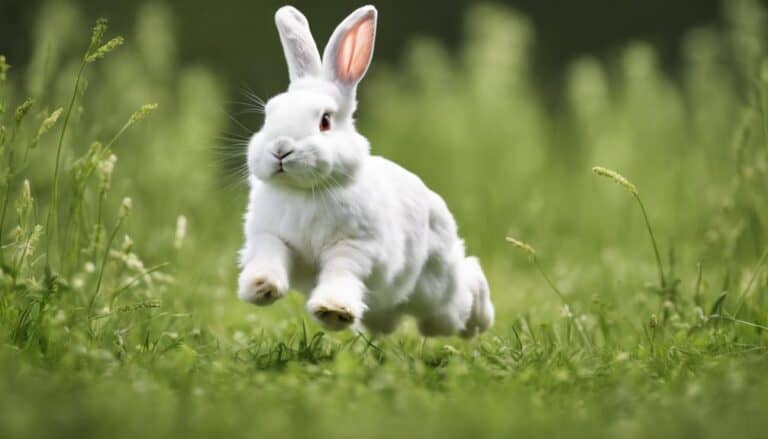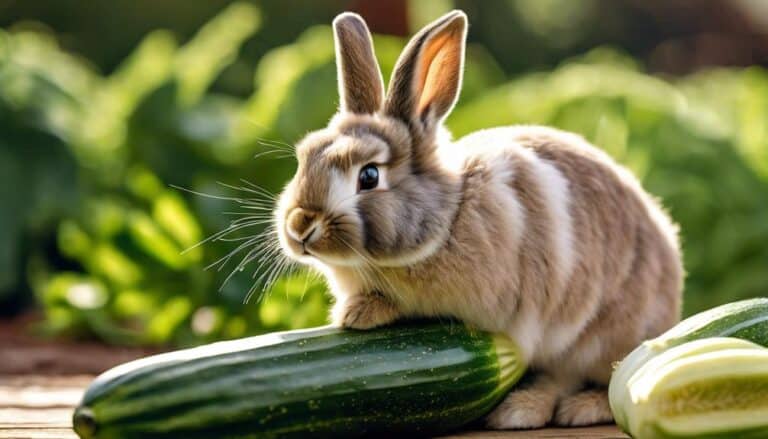In the wild, bunnies rely on their sharp senses to stay safe and find food. Their eyes are always on the lookout for predators, while their twitchy noses pick up on potential dangers and tasty treats. Those big ears not only help them stay cool but also allow them to communicate silently through subtle movements of their fluffy tails. It's like they have their own secret bunny language!
When danger approaches, these clever creatures blend into their surroundings for protection and can dash off at speeds of up to 18 miles per hour to escape. Their strong hind legs give them the power to make quick getaways, and their agility and lightning-fast reflexes can outsmart any threat that comes their way. It's like watching a real-life game of cat and mouse, but with bunnies!
Bunnies also create cozy burrows with multiple entrances and soft linings to keep them safe and snug. They're like the ultimate home designers, making sure their living space is both comfy and secure. And when it comes to food, bunnies are pros at adapting their diets to whatever seasonal goodies are available, making sure they get all the nutrients they need to thrive.
These fluffy creatures also have a knack for teamwork and communication, working together to enhance their chances of survival. It's like they have their own little bunny society, where everyone pitches in to make sure the group stays strong and healthy. Bunnies truly are the masters of resilience and adaptation, showing us all how to thrive in the wild.
Contents
- 1 Key Takeaways
- 2 Bunny Sensory Adaptations
- 3 Predator Detection and Evasion
- 4 Speed and Agility
- 5 Underground Safety Mechanisms
- 6 Nutritional Strategies
- 7 Reproductive Resilience
- 8 Group Communication and Survival
- 9 Frequently Asked Questions
- 10 Do Wild Bunnies Have Special Ways to Protect Their Babies?
- 11 Conclusion
Key Takeaways
Having sharp senses helps animals spot predators and find food easily. They can quickly sense danger and react accordingly.
Animals with speed and agility can escape from predators and outsmart them. They use their quick movements to stay safe and avoid getting caught.
Cozy burrows underground provide a safe and comfortable place for animals to rest and hide. It's like having a snug and secure home to retreat to when needed.
Living in groups helps animals stay safe, share food, and increase their chances of survival. They look out for each other and work together to overcome challenges.
Using tail signals and showing caring behavior helps animals communicate with each other in the group. It builds trust and strengthens their bond, making them a cohesive team.
Bunny Sensory Adaptations
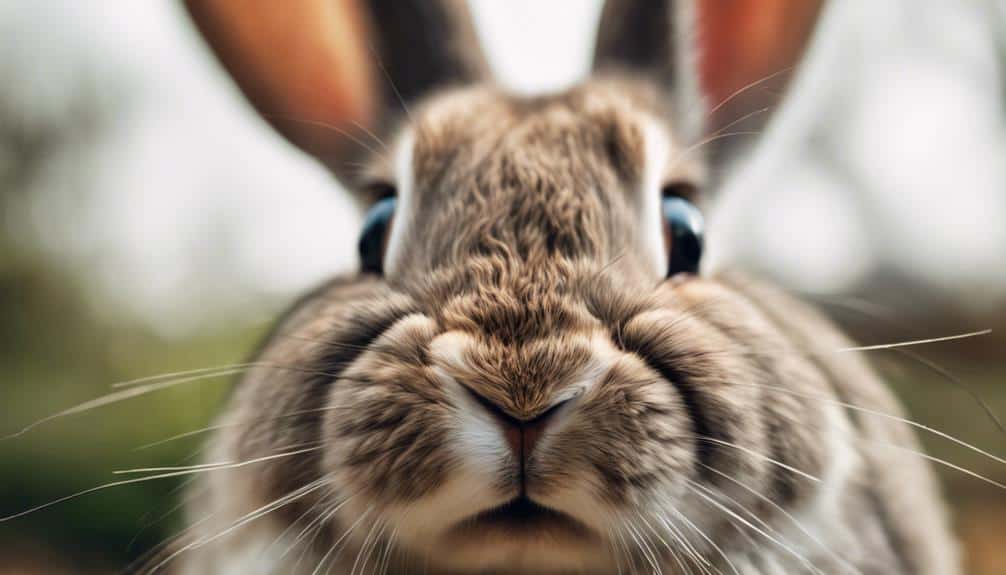
Wild bunnies in the wild rely on their sharp senses to stay safe and find food. They've really good long-distance vision, twitchy noses, and ears that help them stay cool.
Their keen eyesight helps them spot predators from far away, so they can avoid danger. Those twitchy noses are always sniffing around, finding food and sniffing out any nearby trouble. And those ears? They help regulate their body temperature, keeping them comfy in all kinds of weather.
But here's something cool: those fluffy tails aren't just for looks. Wild rabbits use them to talk to each other without making a sound. They move their tails in subtle ways to send messages and warn their buddies about possible dangers. It's like their secret code to keep everyone safe from predators and other risks.
Predator Detection and Evasion
Have you ever noticed how rabbits just seem to disappear into the background with their natural camouflage, making it really tough for predators to find them?
And when danger does come knocking, they can sprint as fast as 18 mph in the blink of an eye to get away.
Those alert ears of theirs are always twitching, showing off their incredible sense of hearing as they stay on high alert for any possible threats.
Camouflage for Hiding
Wild bunnies are pretty smart when it comes to staying safe from predators. They use their fur color to blend in with their surroundings, making it hard for predators to spot them. If they sense danger, these bunnies trust their sharp senses to detect predators early and quickly find a hiding spot. They often choose places like thick bushes or burrows where they can stay hidden.
Bunnies are masters at staying still and not moving a muscle, which helps them avoid being seen by predators. By using these tricks, bunnies can stay safe and increase their chances of surviving in the wild. Their ability to blend in with their environment shows just how clever they're at outsmarting potential threats.
Fast Sprinting Escapes
Bunnies are really good at avoiding getting caught by predators in the wild. They're super quick, able to sprint at speeds of 18-20 miles per hour! Their hind legs are so powerful, helping them dash in crazy zigzag patterns that confuse predators and make it hard for them to keep up.
Plus, their eyesight is top-notch, spotting predators from far away and giving them the heads up to make a quick escape. When danger strikes, bunnies use their speed and agility to outsmart predators, finding safety in burrows or thick bushes.
This fast sprinting skill is a lifesaver for them in the wild, making sure they stay safe and keep thriving in their natural home.
Alert Ears Listening
Rabbits use their amazing hearing to detect and avoid predators in the wild. Their ears can move independently, allowing them to listen carefully for any signs of danger, like predators approaching or strange noises.
When they hear something suspicious, rabbits can quickly figure out if it's a threat and escape before it's too late. With their sharp sense of hearing, they can always be aware of what's going on around them, helping them find safety in underground burrows or thick bushes.
Speed and Agility
Bunnies are really good at getting away from danger fast. They use their quick moves to outsmart predators. These little guys can run as fast as 30 miles per hour when they need to, showing off their awesome agility in the wild.
Speed and agility help bunnies escape from threats quickly and make sure they stay safe in their natural homes.
Quick Escape Strategies
Wild bunnies are super quick and nimble when it comes to dodging predators. They can sprint really fast, hitting speeds of up to 30 miles per hour in short bursts, thanks to their strong hind legs.
When danger lurks, these bunnies can dart in different directions, making sudden turns and zigzagging to throw off any threats that might be chasing them. Their sharp senses help them spot trouble early on, so they can plan their escape routes smartly.
Wild bunnies are really quick on their feet and can zip around in a flash to stay safe from predators. They can reach speeds of up to 30 miles per hour, which helps them outrun any danger that comes their way. These little creatures are experts at navigating through their surroundings with ease, making sudden turns and darting through bushes to avoid being caught.
Their agility is key in their survival game, allowing them to change directions swiftly and dodge predators with finesse. When faced with a threat, bunnies rely on their lightning-fast reflexes to react quickly and escape danger. By using their speed and agility cleverly, bunnies can throw off predators by making sudden moves, making it tough for the predators to keep up and catch them.
In the wild, these skills are a must-have for bunnies to thrive and outsmart any potential threats in their environment. Their ability to adapt and outmaneuver dangers shows just how resourceful these little creatures can be.
Underground Safety Mechanisms
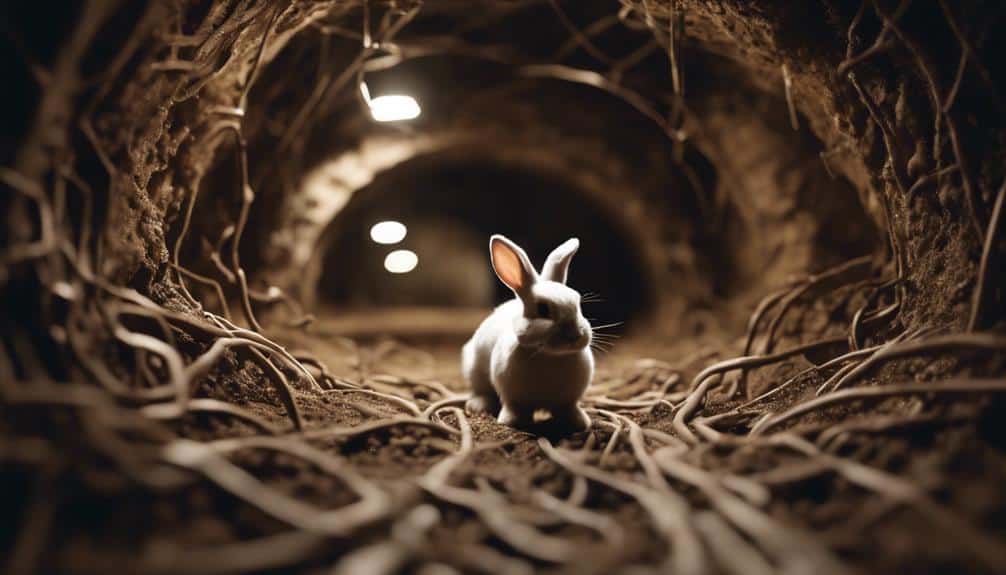
Deep underground, bunnies dig cozy burrows to stay safe from predators and bad weather. These burrows have many doors to escape quickly when danger comes. Bunnies make their burrows comfy by lining them with soft fur and grass, keeping them warm and cozy for their babies. Besides safety, these burrows are hangout spots for bunnies to chill, clean themselves, and stay warm.
Bunnies are smart at making these burrows, making sure they're safe and comfy homes. With these cool burrows, rabbits can handle the wild and feel secure, showing how clever and adaptable they are.
Nutritional Strategies
Wild bunnies are pretty smart about what they eat to stay healthy and strong in different places. When spring and summer roll around and plants that deer like to munch on start growing like crazy, bunnies take advantage of all that tasty food. While deer might look a little rough from their browsing habits, bunnies do great on a menu of grass, leafy greens, twigs, and bark.
These little guys have gotten really good at getting all the important nutrients they need from the plants they eat. Plus, bunnies have a unique habit called coprophagy, where they eat their own poop to make sure they absorb as many nutrients as possible. By switching up their diet depending on what's available each season, wild bunnies make sure they've enough energy and nutrients to keep up with their daily routines.
Their clever eating habits help them do well in different habitats, so they can stay healthy and active out in the wild.
Reproductive Resilience
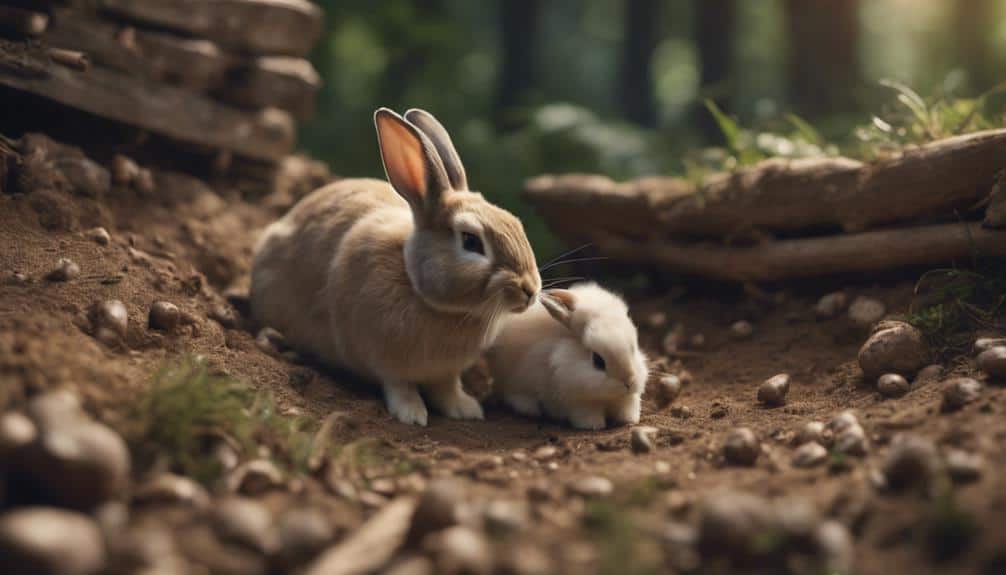
Female rabbits in the wild are pretty amazing when it comes to having babies. They can get pregnant and have little ones in just about a month, which is super fast. This quick turnaround allows them to have lots of litters in a single year, helping their populations stay strong. The baby rabbits are born without hair, blind, and unable to do much on their own, but they grow up quickly and become self-sufficient, which helps them survive when things get tough like losing their habitat.
The adult rabbits keep the population going strong by having babies even in tough conditions. Female rabbits are able to get pregnant right after giving birth, showing how well they can adapt to different environments. By having lots of babies throughout the year, rabbits make sure their species keeps on going and can handle any changes that come their way. Their ability to have babies quickly and raise multiple litters each year shows just how resilient they're in the wild.
Group Communication and Survival
Female wild rabbits are really good at talking to each other without making a sound. They use subtle signals like tail flicks to warn their buddies about potential dangers, making sure everyone stays safe. These bunnies have evolved to be super caring and selfless, always looking out for each other.
Their fluffy white tails aren't just for looks – they're like a secret code for group communication. By flicking their tails or positioning them in certain ways, rabbits can tell their friends where they're or point out yummy food nearby. It's like they've their own silent language going on!
Living in groups is a smart move for rabbits. It helps them stay safe from predators, share food, and move around together. By sticking together, they boost their chances of surviving in the wild. Group communication is key for these fluffy creatures to stay connected and look out for each other.
Frequently Asked Questions
What Helps Rabbits Survive in the Wild?
Rabbits in the wild have some pretty cool survival tricks up their furry sleeves. They rely on their natural instincts to make it through each day. When the weather changes, they know how to adapt by finding ways to stay warm or cool. They're smart little creatures that can handle different temperatures like pros.
One thing rabbits do to stay safe is find shelter in underground dens. These cozy hideouts give them a safe place to rest and hide from any potential threats. It's like having a secret underground bunker where they can chill out until it's safe to come back out.
And when it comes to food, rabbits are all about sticking to their regular sources. They know where to find the good stuff, whether it's tasty greens or crunchy carrots. By sticking to their favorite food spots, they ensure they always have a reliable source of nourishment.
Reproduction is also a big deal for rabbits in the wild. They have behaviors that help them keep their species going strong. By following their natural instincts for mating and raising young rabbits, they ensure that there will always be more bunnies hopping around in the wild.
What Do Rabbits Do All Day in the Wild?
As you watch rabbits in the wild, you'll see them doing all sorts of things. They search for food, hang out with their rabbit buddies, make cozy shelters, claim their turf, and get involved in making more rabbits. It's a busy day in the life of a wild rabbit!
Can a Wild Rabbit Survive on Its Own?
In the natural world, wild rabbits can be seen surviving on their own without any difficulty. They live alone, have amazing skills to find food, rely on their natural instincts, blend in with their surroundings using camouflage, and adapt well to their environment. These qualities help them thrive and do well in the wild.
How Do Bunnies Survive From Predators?
Bunnies are really good at avoiding predators. They do things like blending in with their surroundings, digging burrows to hide in, running super fast to get away, sticking together in groups to protect each other, and adapting really well to their environment. These strategies help them stay safe and live happily in the wild.
Do Wild Bunnies Have Special Ways to Protect Their Babies?
Wild bunnies have a unique way of protecting their babies. When it’s time to move their babies to a new location, mother bunnies carefully pick up their babies in their mouths and hop to the new nest site. This is an example of how bunnies move babies safely in the wild.
Conclusion
In the wild, bunnies survive by using their senses, being quick on their feet, finding safe spots underground, eating well, being good at having babies, and talking to each other. These tactics are essential for their survival, especially in harsh conditions. To prepare for the colder months, bunnies rely on a set of well-honed survival strategies for winter bunnies, which include burrowing deeper into the ground and foraging for food reserves. They also communicate effectively with their peers to ensure they can find warmth and safety together during the colder season.
For instance, if a cottontail rabbit in a forest smells danger, it will run away fast to stay safe.
These tricks help bunnies do well in the wild, showing how tough and flexible they are when faced with tough situations.

